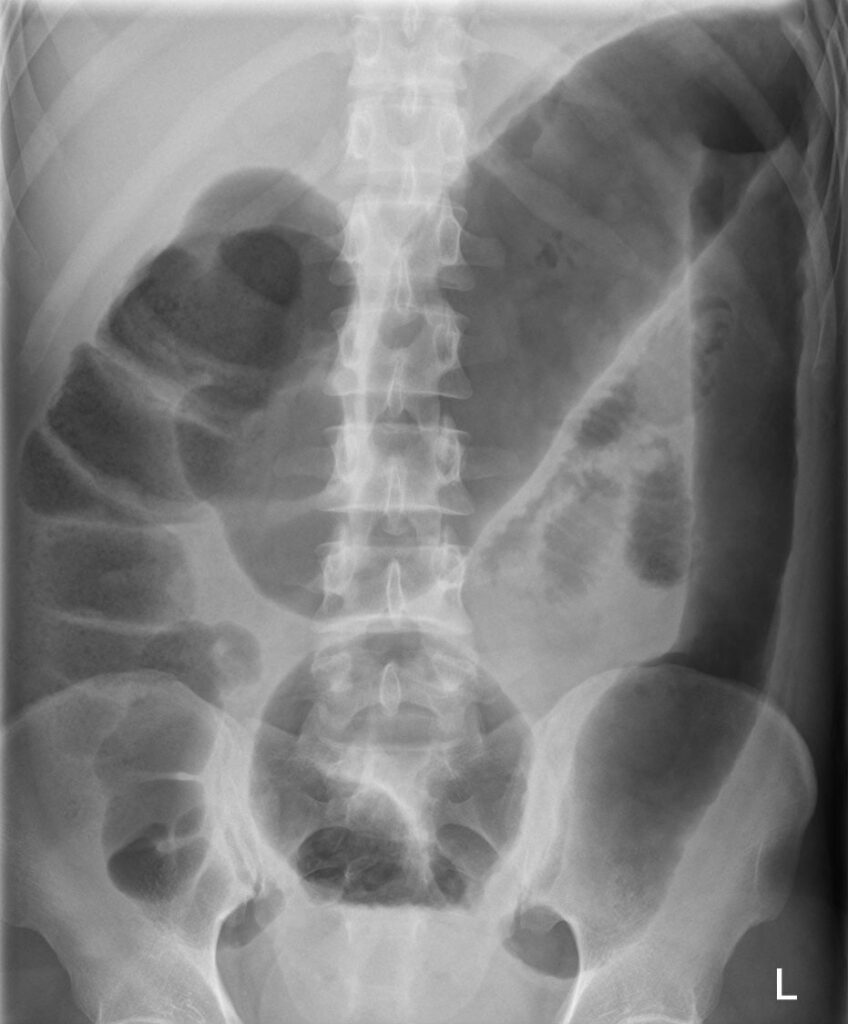Toxic Megacolon;

What is Toxic Megacolon?
Toxic megacolon is a severe complication of inflammatory bowel disease characterized by colonic distention and systemic toxicity. Recognizing its signs and symptoms, understanding its causes, and promptly initiating appropriate treatment are essential to prevent life-threatening complications.
Causes of Toxic Megacolon:
Toxic megacolon is a severe complication of various gastrointestinal conditions, primarily inflammatory bowel disease (IBD). Understanding the underlying causes is essential for early recognition and appropriate management.
Inflammatory Bowel Disease (IBD)
- Ulcerative colitis and Crohn’s disease, the two main types of IBD, are significant contributors to toxic megacolon.
- In ulcerative colitis, inflammation typically starts in the rectum and extends proximally through the colon, leading to severe colonic dilation.
- Crohn’s disease, though primarily affecting the small intestine, can also involve the colon and predispose patients to toxic megacolon.
Infectious Colitis
- Certain bacterial, viral, and parasitic infections can cause colonic inflammation and subsequent dilation, potentially leading to toxic megacolon.
- Infections such as Clostridium difficile colitis, cytomegalovirus (CMV) colitis, and amoebic colitis are known culprits.
- These infections trigger an exaggerated inflammatory response within the colon, resulting in severe complications.
Ischemic Colitis
- Ischemic colitis occurs when blood flow to the colon is compromised, leading to tissue ischemia and inflammation.
- Conditions such as atherosclerosis, thromboembolism, or vasculitis can cause ischemic colitis.
- Prolonged ischemia can lead to colonic dilation and toxic megacolon.
Medications
- Certain medications, particularly those affecting gastrointestinal motility, can predispose individuals to toxic megacolon.
- Antidiarrheal agents, such as opioids, slow colonic transit, leading to bacterial overgrowth and inflammation.
- Nonsteroidal anti-inflammatory drugs (NSAIDs) exacerbate colonic inflammation in patients with underlying IBD, increasing the risk of toxic megacolon.
Other Factors
- Recent Gastrointestinal Surgery: Surgical manipulation of the gastrointestinal tract can disrupt normal bowel function and predispose patients to colonic dilation.
- Severe Dehydration: Inadequate fluid intake or excessive fluid loss can lead to electrolyte imbalances and systemic dehydration, exacerbating colonic inflammation.
- Severe Systemic Illness: Patients with severe systemic illnesses, such as sepsis or systemic lupus erythematosus, may experience colonic inflammation secondary to systemic inflammatory processes.
- Genetic Predisposition: Some individuals may have a genetic predisposition to develop toxic megacolon, although the exact genetic factors remain unclear.
Signs and Symptoms of Toxic Megacolon:
Recognizing the signs and symptoms of toxic megacolon is crucial for prompt diagnosis and intervention. This severe complication of gastrointestinal diseases can rapidly escalate, leading to life-threatening consequences if not addressed promptly.
Abdominal Distention
- Patients with toxic megacolon typically experience significant abdominal distention, often described as bloating or a feeling of fullness.
- The abdomen may appear visibly swollen and tense to the touch, indicating colonic dilation and gas accumulation.
Severe Abdominal Pain
- Intense abdominal pain is a hallmark symptom of toxic megacolon.
- Patients may describe the pain as cramping, sharp, or constant, often localized to the lower abdomen.
- The pain can be debilitating and may worsen with movement or palpation of the abdomen.
Decreased Bowel Movements
- Toxic megacolon is characterized by a marked reduction or cessation of bowel movements.
- Patients may report constipation or a significant decrease in the frequency and volume of stool output.
- Bowel sounds may also be diminished or absent upon auscultation, indicating colonic paralysis.
Systemic Symptoms
- Systemic symptoms of toxicity often accompany toxic megacolon, reflecting the severity of the condition.
- Fever and chills are common, indicating an inflammatory response within the body.
- Rapid heart rate (tachycardia) and low blood pressure (hypotension) may develop as the body attempts to compensate for the systemic effects of inflammation.
Dehydration
- Severe dehydration is a potential complication of toxic megacolon, particularly if patients experience prolonged diarrhea or fluid losses.
- Symptoms of dehydration may include dry mouth, decreased urine output, and lightheadedness.
Altered Mental Status
- In severe cases, toxic megacolon can lead to altered mental status, confusion, or lethargy.
- These neurological symptoms may indicate systemic toxicity and require urgent medical attention.
Rectal Bleeding
- Rectal bleeding or bloody diarrhea may occur in some patients with toxic megacolon, particularly those with underlying inflammatory bowel disease.
- Blood in the stool may be bright red or maroon, indicating active bleeding within the colon.
Shock
- In rare cases, toxic megacolon can progress to septic shock, a life-threatening condition characterized by profound hypotension and organ dysfunction.
- Patients in shock require immediate intensive care management to stabilize their condition.
Risk Factors:
Several factors predispose individuals to toxic megacolon, including a history of inflammatory bowel disease, recent gastrointestinal infection, or medication use. Patients with a long-standing history of ulcerative colitis are particularly at risk, especially during disease flares.
Diagnosis:
Diagnosing toxic megacolon requires a comprehensive approach that combines clinical evaluation, laboratory tests, and radiological imaging. Prompt and accurate diagnosis is essential for initiating appropriate treatment and preventing life-threatening complications.
Clinical Evaluation
- A thorough clinical assessment is the first step in diagnosing toxic megacolon.
- Physicians evaluate patients for characteristic symptoms such as severe abdominal pain, distention, decreased bowel movements, and signs of systemic toxicity.
- A detailed medical history, including any underlying gastrointestinal conditions or recent medication use, helps identify potential risk factors for toxic megacolon.
Laboratory Tests
- Laboratory tests play a crucial role in assessing the severity of inflammation and identifying potential complications.
- Complete blood count (CBC) may reveal leukocytosis, an elevated white blood cell count indicative of inflammation or infection.
- Inflammatory markers such as C-reactive protein (CRP) and erythrocyte sedimentation rate (ESR) are often elevated in patients with active colonic inflammation.
- Electrolyte panels help assess for dehydration and electrolyte imbalances, particularly in patients with prolonged diarrhea.
Radiological Imaging
- Radiological imaging studies aid in confirming the diagnosis of toxic megacolon and assessing for complications such as colonic perforation.
- Abdominal X-ray is often the initial imaging modality performed in suspected cases of toxic megacolon.
- Findings on X-ray may include colonic distention (>6 cm in diameter), thumbprinting (mucosal edema), and air-fluid levels, indicative of colonic dilation and inflammation.
- Computed tomography (CT) scan of the abdomen provides more detailed visualization of the colon and surrounding structures, helping to assess for complications such as perforation or abscess formation.
Endoscopic Evaluation
- Colonoscopy may be performed in stable patients to directly visualize the colonic mucosa and assess for signs of inflammation or ischemia.
- Endoscopic findings consistent with toxic megacolon include mucosal ulcerations, edema, friability, and loss of vascular pattern.
- Colonoscopy also allows for tissue biopsies to be obtained for histological evaluation, aiding in the differential diagnosis and confirming underlying gastrointestinal conditions such as inflammatory bowel disease.
Clinical Criteria
- Several clinical criteria have been proposed to aid in the diagnosis of toxic megacolon, including the Truelove and Witts criteria.
- These criteria typically include a combination of clinical symptoms (e.g., abdominal pain, distention), systemic signs of toxicity (e.g., fever, tachycardia), and radiological findings (e.g., colonic dilation) to establish the diagnosis.
Treatment:
Managing toxic megacolon requires a multidisciplinary approach aimed at stabilizing the patient, reducing colonic inflammation, and preventing complications. Treatment strategies encompass medical therapy, supportive measures, and, in severe cases, surgical intervention.
Medical Therapy
- Intravenous Corticosteroids: High-dose corticosteroids, such as hydrocortisone or methylprednisolone, are the mainstay of medical therapy for tox. megacolon. These medications suppress colonic inflammation and reduce systemic toxicity.
- Immunomodulators: In some cases, immunomodulatory agents such as cyclosporine or infliximab may be considered, particularly in patients with underlying inflammatory bowel disease. These medications help modulate the immune response and promote colonic healing.
- Antibiotics: Broad-spectrum antibiotics may be prescribed to treat underlying infections or prevent secondary bacterial translocation from the inflamed colon. Commonly used antibiotics include metronidazole and ciprofloxacin.
Supportive Measures
- Bowel Rest: Patients with tox. megacolon typically require bowel rest to alleviate colonic distention and reduce inflammation. This involves temporarily withholding oral intake and providing intravenous fluids to maintain hydration.
- Nasogastric Decompression: A nasogastric tube may be inserted to decompress the stomach and reduce abdominal distention. However, it does not decompress the colon directly.
- Nutritional Support: Once the patient’s condition stabilizes, gradual reintroduction of enteral nutrition is initiated to promote gut healing and prevent malnutrition.
Surgical Intervention
- Subtotal Colectomy: In severe cases of tox. megacolon refractory to medical therapy or complicated by perforation, surgical intervention may be necessary. Subtotal colectomy with ileostomy is the preferred surgical approach, aiming to remove the diseased colon and prevent further complications.
- Timing of Surgery: The decision to proceed with surgery depends on various factors, including the patient’s clinical status, response to medical therapy, and presence of complications such as perforation or uncontrolled sepsis. Early surgical consultation is essential to determine the optimal timing for intervention.
Monitoring and Follow-up
- Close monitoring of the patient’s clinical status, vital signs, and laboratory parameters is essential throughout the treatment course.
- Regular assessment of bowel function, abdominal distention, and signs of systemic toxicity helps guide therapeutic decisions and identify potential complications.
- Long-term follow-up is necessary to monitor for disease recurrence, assess surgical outcomes, and address any complications or sequelae of tox. megacolon.
Differential Diagnosis:
Distinguishing toxic megacolon from other causes of colonic dilation is crucial. Conditions such as Hirschsprung disease, acquired megacolon, colonic pseudo-obstruction (Ogilvie syndrome), and diffuse gastrointestinal dysmotility may present similarly and require careful evaluation to prevent delays in treatment.
Prognosis:
Despite advances in treatment, tox. megacolon remains a serious condition with significant morbidity and mortality. Early intervention, including prompt recognition and appropriate medical or surgical management, is associated with better outcomes. However, complications such as bowel perforation and peritonitis can significantly worsen prognosis if not addressed promptly
Complications:
Failure to promptly treat tox. megacolon can lead to life-threatening complications, including bowel perforation, peritonitis, abscess formation, and abdominal compartment syndrome. These complications necessitate immediate surgical intervention to prevent further morbidity and mortality.
In conclusion, toxic megacolon requires a multidisciplinary approach involving gastroenterologists, surgeons, and critical care specialists. Early recognition, aggressive medical management, and timely surgical intervention are paramount in improving patient outcomes and reducing the risk of complications.


Pingback: Common Health Conditions - Modern Health